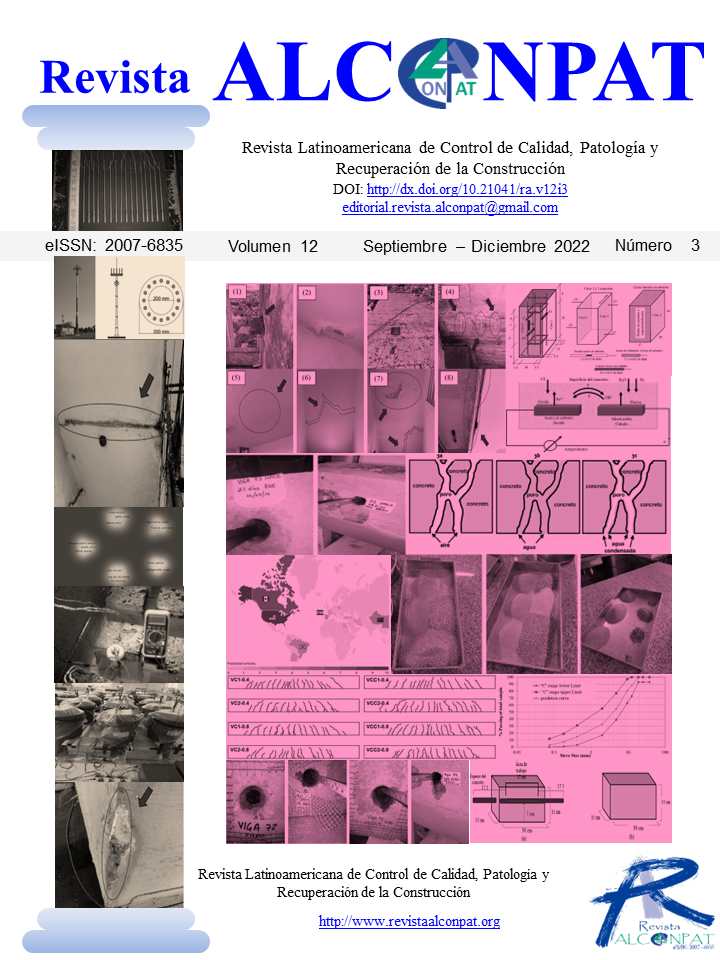Electrochemical realkalinization applied to carbonated concrete samples under the criteria of three standards
DOI:
https://doi.org/10.21041/ra.v12i3.619Keywords:
electrochemical realkalinization, pH, half-cell potential, current intensityAbstract
The effect of electrochemical realkalinization was evaluated by applying the standards UNE-EN-1504, NACE-SP0107-2007 and NMX-C-553-ONNCCE-2018, on previously carbonated reinforced concrete samples. With the monitoring of the degree of realkalinization, through pH and half-cell potential measurements at 7, 14, 21 and 28 days, pH recovery is observed in all cases, obtaining characteristic half-cell potential values in each current application, which confirms the polarization of the steel modifying the thermodynamic condition of the concrete-steel interface and causing chemical changes in the concrete paste. With the NMX-C-553-ONNCCE-2018 standard the steel was polarized without reaching the overprotection region, avoiding the risk of producing hydrogen and brittleness in the steel.
Downloads
References
Aguirre-Guerrero, A. M., & de Gutiérrez, R. M. (2018), Efficiency of electrochemical realkalisation treatment on reinforced blended concrete using FTIR and TGA. Construction and Building Materials, 193, 518-528. DOI: 10.1016/j.conbuildmat.2018.10.195
Aguirre-Guerrero, A. M., Mejía-de-Gutiérrez, R., Montês-Correia, M. J. R. (2016), Corrosion performance of blended concretes exposed to different aggressive environments. Construction and Building Materials, 121, 704-716. DOI:10.1016/j.conbuildmat.2016.06.038
Annual Book of ASTM Standards (2016), Construction. Chemical-resistant materials; vitrified clay, concrete, fiber-cement products; mortars; masonry. Section 4. Vol. 04.05.
Andrade, C., Alonso, C., Rodríguez, J. (1989), Remaining service life of corroding structures. IABSE Symposium on Durability, Lisbon, Sep., pp. 359-363.
ASTM C876-15. Standard Test Method for Corrosion Potentials of Uncoated Reinforcing Steel in Concrete.
Bize, B. (2001), Béton armé corrode: Les traitement électrochimiques. In: CSTB Magazine, No. 136. juillet - aoùt 2001.
Castellote, M., Llorente, I., Andrade, C. (2003), Influence of the external solution in the electroosmotic flux induced by realkalisation. in: Mater. Construcc., vol. 53, no 271– 272. pp. 101–111. DOI: https://doi.org/10.3989/mc.2003.v53.i271-272.294
Castellote, M., Llorente, I., Andrade, C., Turrillas, X., Alonso, C., Campo, J. (2006), In-situ monitoring the realkalisation process by neutron diffraction: electro-osmotic flux and portlandite formation. Cem Concr Res. 36:791–800. https://doi.org/10.1016/j.cemconres.2005.11.014
Castellote M., Llorente, I., Andrade C., Turrillas, X, Alonso, C., Campo, J. (2006), Neutron diffraction as a tool to monitor the establishment of the electro-osmotic flux during realkalisation of carbonated concrete. Physica B. 385– 386:26–528. https://doi.org/10.1016/j.physb.2006.05.263
Chatterji, S. (1994), Simultaneous chloride removal and realcalisation of old concrete structures. Cement and Concrete Research 24. No. 6. pp. 1051 -1054. DOI:10.1016/0008-8846(94)90028-0
CYTED - DURAR. Manual de Inspección, Evaluación y Diagnóstico de Corrosión en Estructuras de Hormigón Armado. Reporte Final, Red Durar, CYTED, Maracaibo, (1997).
Fajardo, G., Escadeillas G., Arliguie, G. (2006), Electrochemical chloride extraction (ECE) from steel reinforced concrete specimens contaminated from artificial seawater. Corrosion Science 48, pp: 110-125. https://doi.org/10.1016/j.corsci.2004.11.015
Del Valle Moreno, A., Pérez-López T., Martínez Madrid, M. (2001), El fenómeno de la corrosión en estructuras de concreto reforzado. Publicación Técnica No. 182, Secretaría de Comunicaciones y Transportes, Instituto Mexicano del Transporte, Sanfandila, Querétaro.
González Díaz, F. (2010), Realcalinización electroquímica del concreto reforzado carbonatado: una opción de prevención contra la corrosión. Doctorado thesis, Universidad Autónoma de Nuevo León.
González, F., Fajardo, G., Arliguie, G., Juárez, C. A., Escadeillas, G. (2011), Electrochemical Realkalisation of Carbonated Concrete: An Alternative Approach to Prevention of Reinforcing Steel Corrosion. International Journal of Electrochemical Science. 6. pp 6332 – 6349.
Helene, P., Monteiro, J. (1994), Can local repairs be durable solutions for steel corrosion in concrete structures. Annals of international Conference on Corrosion and Corrosion Protection of Steel in Concrete, Vol. 2.
Linares, D., Sánchez, M. (2003), Construction, operation and performance of a chamber for tests of accelerated carbonation. Rev. Tec Ing. Univ Zulia, 26, 34-44.
Mietz, J. (1995), Electrochemical realkalisation for rehabilitation of reinforced concrete structures. Materials and corrosion. 46(9), 527-533. https://doi.org/10.1002/maco.19950460904
Mietz, J. (1998), Electrochemical rehabilitation methods for reinforced concrete structures a state of the art report. EFC N°24, IOM Communications Ltd, London.
NACE (2007), SP0107-2007 Electrochemical Realkalization and Chloride Extraction for Reinforced Concrete
Normas mexicanas del ONNCCE (2018), NMX-C-111-ONNCCE-2018 Industria de la Construcción-Agregados para concreto hidráulico-Especificaciones y métodos de ensayo.
Normas mexicanas del ONNCCE (2017), NMX-C-414-ONNCCE-2017 Industria de la Construcción - Cementantes Hidráulicos - Especificaciones y Métodos de Ensayo.
Normas mexicanas del ONNCCE (2015), NMX-C-495-ONNCCE-2015 Industria de la Construcción - Durabilidad de Estructuras de Concreto Reforzado - Medición de Potenciales de Corrosión del Acero de Refuerzo sin Revestir, Embebido en Concreto - Especificaciones y Método de Ensayo.
Normas mexicanas del ONNCCE (2018), NMX-C-553-ONNCCE-2018 Industria de la construcción - Concreto - Durabilidad - Métodos Electroquímicos de Rehabilitación (Intervención) Especializados (Realcalinización y Remoción de Cloruros) - Especificaciones y Métodos de Ensayo
Norma ACI 211.1. Diseño de mezcla de concreto patrón.
Pollet, V., Dieryck, V. (2000), Re - alkalization: specification for the treatment application and acceptance criteria. Annual Progress Report, 1999 - 2000, COST 521, Workshop, Belfast, p. 271.
Raharinaivo and Carpio, J. (1992). The stepping down the current method: a new corrosion control for cathodic protection of steel. Paper No. 228, NACE Conference Corrosion 92, Nashville USA, p. 9.
Hussain, R. R., Tetsuya, I. (2011), Enhanced electro-chemical corrosion model forreinforced concrete under severe coupled actions of chloride and temperature. Construction and Building Materials Journal. Vol. 25, Issue 3. pp. 1305-1315, Elsevier, ISI.
https://doi.org/10.1016/j.conbuildmat.2010.09.014
Redaelli, E., Bertolini, L. (2011), Electrochemical repair techniques in carbonated concrete. Part I: electrochemical realkalisation. J Appl Electrochem 41, 817–827. DOI:10.1007/s10800-011-0301-4
Ribeiro, P. H. L. C., Meira, G. R., Ferreira, P. R. R., Perazzo, N. (2013), Electrochemical Realkalisation of Carbonated Concretes – Influence of Material Characteristics and Thickness of Concrete Reinforcement Cover. Elsevier. Construction and Building Materials 40. 280-290. https://doi.org/10.1016/j.conbuildmat.2012.09.076
Rincón, T., Rincón, O. (1994), Electrochemical evolution of mortar based on acrylic and epoxy resins used to repair concrete structures. 1st Mexican Symposium and 2nd International Workshop on Metallic Corrosion, Mérida, México.
Tong, Y., Bouteiller, V., Marie-Victoire, E. Joiret, S. (2012). Efficiency Investigations of Electrochemical Realkalisation Treatment Applied to Carbonated Reinforced Concret. Part 1: saacrifical anode process. Cem. Concr. Res. 42 (1), 84-94. DOI:10.1016/j.cemconres.2011.08.008
Tuutti, K. (1982). Corrosion of steel in concrete. Report 4.82, The Swedish Cement and Concrete Association, Stockholm.
UNE-EN 1504 Norma de productos y sistemas para la protección y reparación de estructuras de hormigón.
Yeih, W., Chang, J. J. (2005), A study on the efficiency of electrochemical realkalisation of carbonated concrete. Construction and Building Materials 19. 516-524 p. https://doi.org/10.1016/j.conbuildmat.2005.01.006
Downloads
Published
How to Cite
Issue
Section
License
_______________________________
License in effect from September 2020
You are free to:
- Share — copy and redistribute the material in any medium or format for any purpose, even commercially.
- Adapt — remix, transform, and build upon the material for any purpose, even commercially.
- The licensor cannot revoke these freedoms as long as you follow the license terms.
Under the following terms:
- Attribution — You must give appropriate credit , provide a link to the license, and indicate if changes were made . You may do so in any reasonable manner, but not in any way that suggests the licensor endorses you or your use.
- No additional restrictions — You may not apply legal terms or technological measures that legally restrict others from doing anything the license permits.
Notices:
You do not have to comply with the license for elements of the material in the public domain or where your use is permitted by an applicable exception or limitation .
No warranties are given. The license may not give you all of the permissions necessary for your intended use. For example, other rights such as publicity, privacy, or moral rights may limit how you use the material.





















.png)














